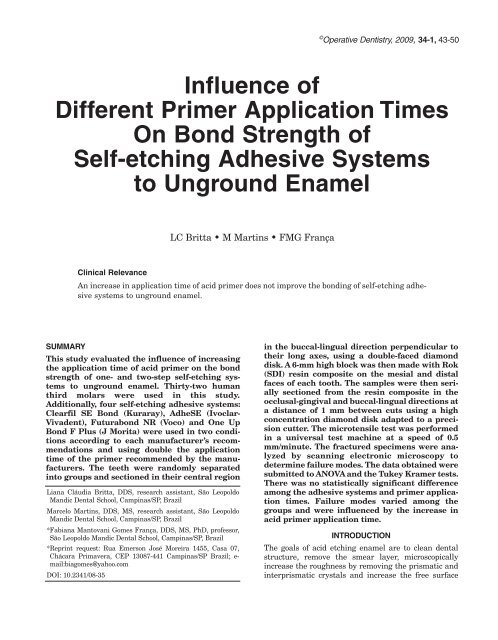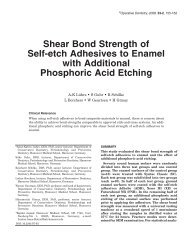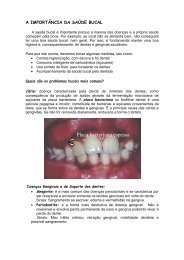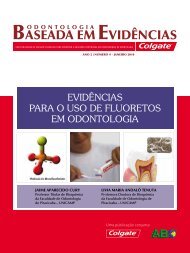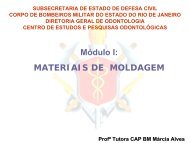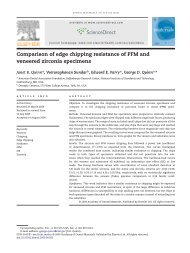Influence of Different Primer Application Times On Bond Strength of ...
Influence of Different Primer Application Times On Bond Strength of ...
Influence of Different Primer Application Times On Bond Strength of ...
You also want an ePaper? Increase the reach of your titles
YUMPU automatically turns print PDFs into web optimized ePapers that Google loves.
© Operative Dentistry, 2009, 34-1, 43-50<br />
<strong>Influence</strong> <strong>of</strong><br />
<strong>Different</strong> <strong>Primer</strong> <strong>Application</strong> <strong>Times</strong><br />
<strong>On</strong> <strong>Bond</strong> <strong>Strength</strong> <strong>of</strong><br />
Self-etching Adhesive Systems<br />
to Unground Enamel<br />
SUMMARY<br />
This study evaluated the influence <strong>of</strong> increasing<br />
the application time <strong>of</strong> acid primer on the bond<br />
strength <strong>of</strong> one- and two-step self-etching systems<br />
to unground enamel. Thirty-two human<br />
third molars were used in this study.<br />
Additionally, four self-etching adhesive systems:<br />
Clearfil SE <strong>Bond</strong> (Kuraray), AdheSE (Ivoclar-<br />
Vivadent), Futurabond NR (Voco) and <strong>On</strong>e Up<br />
<strong>Bond</strong> F Plus (J Morita) were used in two conditions<br />
according to each manufacturer’s recommendations<br />
and using double the application<br />
time <strong>of</strong> the primer recommended by the manufacturers.<br />
The teeth were randomly separated<br />
into groups and sectioned in their central region<br />
LC Britta M Martins FMG França<br />
Clinical Relevance<br />
An increase in application time <strong>of</strong> acid primer does not improve the bonding <strong>of</strong> self-etching adhesive<br />
systems to unground enamel.<br />
Liana Cláudia Britta, DDS, research assistant, São Leopoldo<br />
Mandic Dental School, Campinas/SP, Brazil<br />
Marcelo Martins, DDS, MS, research assistant, São Leopoldo<br />
Mandic Dental School, Campinas/SP, Brazil<br />
*Fabiana Mantovani Gomes França, DDS, MS, PhD, pr<strong>of</strong>essor,<br />
São Leopoldo Mandic Dental School, Campinas/SP, Brazil<br />
*Reprint request: Rua Emerson José Moreira 1455, Casa 07,<br />
Chácara Primavera, CEP 13087-441 Campinas/SP Brazil; email:biagomes@yahoo.com<br />
DOI: 10.2341/08-35<br />
in the buccal-lingual direction perpendicular to<br />
their long axes, using a double-faced diamond<br />
disk. A 6-mm high block was then made with Rok<br />
(SDI) resin composite on the mesial and distal<br />
faces <strong>of</strong> each tooth. The samples were then serially<br />
sectioned from the resin composite in the<br />
occlusal-gingival and buccal-lingual directions at<br />
a distance <strong>of</strong> 1 mm between cuts using a high<br />
concentration diamond disk adapted to a precision<br />
cutter. The microtensile test was performed<br />
in a universal test machine at a speed <strong>of</strong> 0.5<br />
mm/minute. The fractured specimens were analyzed<br />
by scanning electronic microscopy to<br />
determine failure modes. The data obtained were<br />
submitted to ANOVA and the Tukey Kramer tests.<br />
There was no statistically significant difference<br />
among the adhesive systems and primer application<br />
times. Failure modes varied among the<br />
groups and were influenced by the increase in<br />
acid primer application time.<br />
INTRODUCTION<br />
The goals <strong>of</strong> acid etching enamel are to clean dental<br />
structure, remove the smear layer, microscopically<br />
increase the roughness by removing the prismatic and<br />
interprismatic crystals and increase the free surface
44<br />
energy to produce sufficient monomer infiltration, seal<br />
the surface with adhesive and contribute to the retention<br />
<strong>of</strong> resin composite restorations. 1<br />
It is known that the presence <strong>of</strong> nanometric-sized<br />
spaces at the base <strong>of</strong> the hybrid layer can be produced<br />
by the lack <strong>of</strong> resin penetration throughout the demineralized<br />
layer thickness or by the removal <strong>of</strong> poorly<br />
polymerized resin by oral or dentinal fluids. For this<br />
reason, performing acid etching, together with the<br />
adhesive system primer, for demineralization and<br />
resinous penetration to occur simultaneously, the use <strong>of</strong><br />
self-etching primers was proposed. 2-3<br />
The bond strength <strong>of</strong> adhesive systems to enamel<br />
etched with acid attains values <strong>of</strong> more than 40 MPa, 4<br />
characterizing a highly reliable bond. However, selfetching<br />
adhesives have weaker acids, with a higher pH<br />
than that <strong>of</strong> phosphoric acid, and they are not as effective<br />
for demineralizing enamel when compared with<br />
conventional adhesives. 5<br />
Conventional adhesive systems show a deep interprismatic<br />
acid etching pattern on enamel, and the pattern<br />
for the self-etching adhesive system ranges from<br />
absent to moderate. 6 However, there is no correlation<br />
between deep acid attack and bond strength between<br />
resin and enamel. 7 The degree <strong>of</strong> acid attack <strong>of</strong> selfetching<br />
systems on enamel appears to be minimal,<br />
despite the bond strength to enamel being acceptable.<br />
8-9<br />
The performance <strong>of</strong> self-etching systems with regard<br />
to bond strength to enamel and clinical marginal degradation<br />
is inferior when compared with conventional<br />
systems. 10-12 Some authors have suggested techniques<br />
that recommend the use <strong>of</strong> 37% phosphoric acid on<br />
enamel before using self-etching adhesives to increase<br />
their retentive strength, 13-16 which could result in selfetching<br />
systems being clinically impractical.<br />
Other authors have suggested increasing the time <strong>of</strong><br />
enamel etching with the acid primer <strong>of</strong> self-etching<br />
adhesives on prepared enamel, which could increase<br />
the bond strength and retain the practicality <strong>of</strong> the selfetching<br />
adhesive application by eliminating the clinical<br />
steps <strong>of</strong> washing the acid and drying the teeth. 17-18<br />
To assess the performance <strong>of</strong> self-etching systems on<br />
enamel, the current study evaluated the influence <strong>of</strong><br />
increasing the application time <strong>of</strong> the acid primer on<br />
the bond strength to unground enamel.<br />
METHODS AND MATERIALS<br />
Thirty-two human third molars were used in this study<br />
(n=4). After extraction, the teeth were cleaned with a<br />
water slurry <strong>of</strong> pumice flour in a rubber prophylaxis<br />
cup at low speed and stored in distilled water at room<br />
temperature to prevent dehydration.<br />
Operative Dentistry<br />
The mesial and distal faces <strong>of</strong> the specimens were<br />
used for bonding to unground enamel. The teeth were<br />
randomly separated and sectioned in their central<br />
region in the buccal-lingual direction parallel to their<br />
long axes using a double-faced diamond disk<br />
(Microdont Micro Usinagem de Precisão Ltda, São<br />
Paulo, SP, Brazil) at low speed under water/air cooling.<br />
The self-etching adhesive systems were applied on the<br />
enamel surface in accordance with each manufacturer’s<br />
recommendations and also applied at double the length<br />
<strong>of</strong> the primer application time recommended by the<br />
manufacturer. The commercial brand name, basic composition,<br />
pH, manufacturers, method <strong>of</strong> use and lot<br />
numbers <strong>of</strong> the adhesive systems used in this study are<br />
listed in Table 1.<br />
After application <strong>of</strong> the adhesive systems, a 6 mm<br />
high resin composite block (Rok—Lot #031156/SDI,<br />
Melbourne, Victoria, Australia) was prepared. The<br />
resin was placed in three increments, each <strong>of</strong> which was<br />
individually light polymerized for 40 seconds with a<br />
LED Radii/SDI appliance at 1.500 mW/cm² power and<br />
periodically calibrated using the radiometer within the<br />
appliance. The samples were stored in distilled water at<br />
37°C ± 1°C for 24 hours.<br />
The samples were then serially sectioned from the<br />
resin composite in the occlusal-gingival and buccal-lingual<br />
directions at a 1 mm distance between the cuts<br />
using a high concentration diamond disk in a precision<br />
cutter (Isomet 1000, Buehler, Lake Bluff, IL, USA). The<br />
specimens consisted <strong>of</strong> resin composite bonded to<br />
unground enamel (on the mesial and distal faces) in the<br />
form <strong>of</strong> beams. For each tooth, a minimum <strong>of</strong> four<br />
beams was obtained. With the aid <strong>of</strong> a cyanoacrylatebased<br />
adhesive (Super <strong>Bond</strong>er Gel, Henkel Loctite<br />
Adhesives Ltda, Itapevi, São Paulo, Brazil), the ends <strong>of</strong><br />
the specimens were fixed to the grips <strong>of</strong> a microtensile<br />
device coupled to the universal test machine DL 2000<br />
(EMIC Equipamentos e Sistemas de Ensaio Ltda, São<br />
José dos Pinhais, PR, Brazil).<br />
The tensile bond strength was performed at 0.5<br />
mm/minute until the sample ruptured. After the test,<br />
the specimen was carefully removed from the device<br />
with a scalpel blade and the fracture region area was<br />
measured to approximately 0.01 mm with a digital<br />
pachymeter (Starret 727-6/150, Itu SP/Brazil) to calculate<br />
the final shear force expressed in MPa.<br />
After the microtensile test, the enamel portions were<br />
separated and fixed to aluminum stubs (Procind Ltda,<br />
Piracicaba, São Paulo, Brazil) with the fractured interfaces<br />
facing upward, metalized (SCD 050 Sputter<br />
Coater, Baltec) and evaluated by scanning electronic<br />
microscopy (JEOL, JSM-5900LV scanning electronic<br />
microscope, Tokyo, Japan) to determine the failure<br />
modes (adaptation <strong>of</strong> the model described by Montes<br />
and others19 and Tanumiharja and others): Type 1,
Britta & Others: <strong>Influence</strong> <strong>of</strong> <strong>Primer</strong> <strong>Application</strong> <strong>Times</strong> <strong>On</strong> the <strong>Bond</strong> <strong>Strength</strong> <strong>of</strong> Self-etching Adhesive Systems 45<br />
Table 1: <strong>Bond</strong>ing Systems Used<br />
System<br />
Manufacturer Composition <strong>Bond</strong>ing Steps pH<br />
Batch # (main components)<br />
Clearfil SE <strong>Bond</strong> <strong>Primer</strong>: MDP, HEMA, hydrophilic Apply a layer <strong>of</strong> primer, wait 20 2.1<br />
(Kuraray) dimethacrylate, CQ, N,N-Diethanol seconds, dry with a light jet <strong>of</strong> air,<br />
p-toluidine, water apply the adhesive, remove the excess<br />
<strong>Primer</strong>: 00616A <strong>Bond</strong>: MDP, BisGMA, HEMA, with a light jet <strong>of</strong> air and light<br />
<strong>Bond</strong>: 00872A hydrophobic dimethacrylate, CQ,<br />
N, N-Dietanol p-toluidine, Silanate<br />
colloidal silica<br />
polymerize for 10 seconds.<br />
AdheSE <strong>Primer</strong>: phosphoric acid acrylate, Apply a layer <strong>of</strong> primer, wait 30 seconds, 1.7<br />
(Ivoclar-Vivadent) bis-acrylic acid amide, water, initiators, disperse the excess with a strong<br />
stabilizers jet <strong>of</strong> air, apply the adhesive, remove<br />
<strong>Primer</strong>: J00781<br />
<strong>Bond</strong>: J03128<br />
<strong>Bond</strong>: dimethacrylate, hydroxyl ethyl<br />
methacrylate, highly dispersed silicon<br />
dioxide, initiators, stabilizers<br />
the excess with a light jet <strong>of</strong> air and light<br />
polymerize for 10 seconds.<br />
Futurabond NR BIS-GMA, hydroxyl ethyl methacrylate, Dispense one drop <strong>of</strong> each agent into 1.4<br />
(Voco) BHT, ethanol, organic acids, fluorides the mixing capsule, mix the two agents,<br />
apply the mixture to the dental<br />
Liquid A: 620683 Liquid A–Methacryloyloxyalkyl acid structure for 20 seconds, dry and<br />
Liquid B: 620684 phosphate (phosphoric acid monomer), light polymerize for 10 seconds.<br />
<strong>On</strong>e Up <strong>Bond</strong> 11-Methacryloxy-1,1-undecanedicarboxylic Dispense one drop <strong>of</strong> each agent 0.8<br />
F Plus acid (MAC-10), Methyl methacrylate into the mixing capsule, mix the two<br />
(J Morita) agents until a homogeneous pink<br />
color is obtained, apply the mixture<br />
Liquid A: 036M Liquid B–2-Hidroxyethyl methacrylate, to the dental structure, wait 20<br />
Liquid B: 530M L Methyl methacrylate seconds, do not remove the excess<br />
and light polymerize for 10 seconds<br />
or longer to guarantee color change<br />
from pink to colorless.<br />
Figure 1. Demonstrates adhesive failure, fracture mode Type 1.<br />
adhesive failure between the adhesive and enamel<br />
(Figure 1); Type 2, partial adhesive failure between the<br />
adhesive system and enamel, and partial cohesive failure<br />
in the adhesive (Figure 2); Type 3, completely cohesive<br />
in the adhesive system (Figure 3 ); Type 4, partially<br />
cohesive in enamel; Type 5, partially cohesive resin<br />
composite. 19-20<br />
The data obtained were tabulated and submitted to<br />
Analysis <strong>of</strong> Variance and the Tukey Kramer tests. The<br />
Figure 2. Demonstrates partial adhesive failure and partial<br />
cohesive failure in adhesive, Fracture mode Type 2.<br />
results <strong>of</strong> the fracture pattern evaluation were submitted<br />
to descriptive statistical analysis.<br />
RESULTS<br />
The results are described in Table 2 and Figure 4. The<br />
highest mean bond strength value was obtained by the<br />
Clearfil SE <strong>Bond</strong> system when the primer was applied<br />
for double the time recommended by the manufacturer.<br />
Among all the adhesive systems, only Futurabond NR
46 Operative Dentistry<br />
Figure 3. Demonstrates cohesive failure in the adhesive, Fracture mode Type 3.<br />
obtained a lower mean bond strength when the primer<br />
was applied for double the time recommended by the<br />
manufacturer. There was no statistically significant difference<br />
among the groups according to the Analysis <strong>of</strong><br />
Variance and Tukey Kramer tests (p=0.3906, Table 2).<br />
Figure 4. Mean and standard deviation <strong>of</strong> tensile bond strength as a function <strong>of</strong> the adhesive<br />
systems.<br />
Adhesives Systems <strong>Primer</strong> <strong>Application</strong> Time Mean (SD) Tukey<br />
Futurabond NR 20 28.8 (14.5) A<br />
40 26.2 (10.8) A<br />
AdheSE 30 27.8 (10.5) A<br />
60 30.0 (8.6) A<br />
<strong>On</strong>e Up <strong>Bond</strong> F 20 30.2 (11.8) A<br />
40 30.8 (15.0) A<br />
Clearfil SE <strong>Bond</strong> 20 30.1 (16.8) A<br />
40 34.5 (16.4) A<br />
However, it was<br />
observed that<br />
the two-step<br />
adhesive systems<br />
presented<br />
higher mean<br />
bond strength<br />
values to enamel<br />
when they<br />
were applied for<br />
double the time<br />
recommended<br />
by the manufacturer.<br />
The data<br />
obtained in the<br />
fracture pattern<br />
analysis were analyzed by frequencies distribution. The<br />
fracture mode analysis <strong>of</strong> the specimens bonded with<br />
one-step application adhesives (Futura <strong>Bond</strong> and <strong>On</strong>e<br />
Up <strong>Bond</strong> F) demonstrated that, when doubling the<br />
primer application time, there was an<br />
increase in the percentage <strong>of</strong> Type 1 fractures,<br />
while the percentages <strong>of</strong> Type 2<br />
fractures remained similar. However, a<br />
lower percentage <strong>of</strong> Type 3 fractures<br />
occurred (Table 3 and Figure 5). In the<br />
two-step application adhesive systems<br />
(Clearfil SE <strong>Bond</strong> and AdheSE), the percentage<br />
<strong>of</strong> Type 1 fractures diminished<br />
with an increase in primer application<br />
time, the frequency <strong>of</strong> Type 2 fractures<br />
remained similar and the percentage <strong>of</strong><br />
Type 3 fractures increased (Table 3 and<br />
Figure 5).<br />
Table 2: Mean and Standard Deviation <strong>of</strong> Tensile <strong>Bond</strong> <strong>Strength</strong> as a Function <strong>of</strong> the Adhesive System<br />
and <strong>Primer</strong> <strong>Application</strong> Time<br />
Means followed by the same letter do not differ statistically (p>0.05) by the ANOVA and Tukey tests.<br />
DISCUSSION<br />
Enamel debridement by cavity preparation<br />
could improve the tissue response to<br />
acid etching, 21 with some studies verifying<br />
the bonding <strong>of</strong> self-etching systems<br />
to prepared enamel on the occlusal, lingual<br />
and buccal<br />
faces. 10,22-23<br />
However, it<br />
should be taken<br />
into account that<br />
restorations are<br />
commonly extended<br />
beyond the margins<br />
<strong>of</strong> the cavity preparations<br />
or they are<br />
performed without<br />
any enamel preparation,<br />
such as a<br />
number <strong>of</strong> conser-
Britta & Others: <strong>Influence</strong> <strong>of</strong> <strong>Primer</strong> <strong>Application</strong> <strong>Times</strong> <strong>On</strong> the <strong>Bond</strong> <strong>Strength</strong> <strong>of</strong> Self-etching Adhesive Systems<br />
Table 3: Distribution and Frequency (%) <strong>of</strong> the Type <strong>of</strong> Fracture as a Function <strong>of</strong> the Group<br />
Group Type <strong>of</strong> Fracture<br />
1 2 3 4<br />
Futura 20 2 (8.0%) 5 (20.0%) 18 (72.0%) 0 (0.0%)<br />
Futura 40 6 (23.1%) 9 (34.6%) 10 (38.5%) 1 (3.8%)<br />
Adhese 30 5 (27.8%) 10 (55.6%) 2 (11.1%) 1 (5.6%)<br />
Adhese 60 1 (7.7%) 8 (61.5%) 4 (30.8%) 0 (0.0%)<br />
<strong>On</strong>e Up 20 6 (23.1%) 12 (46.2%) 8 (30.8%) 0 (0.0%)<br />
<strong>On</strong>e Up 40 8 (30.8%) 12 (46.2%) 6 (23.1%) 0 (0.0%)<br />
Clearfil 20 5 (22.7%) 9 (40.9%) 7 (31.8%) 1 (4.5%)<br />
Clearfil 40 3 (16.7%) 4 (22.2%) 11 (61.1%) 0 (0.0%)<br />
1-adhesive failure between the adhesive and enamel; 2-partial adhesive failure between the adhesive system and enamel, and partial cohesive in the<br />
adhesive; 3-completely cohesive failure in the adhesive system; 4-partially cohesive failure in enamel; 5-partially cohesive resin composite failure.<br />
Figure 5. Percentage <strong>of</strong> fracture modes found in each primer application time.<br />
vative restorative treatments, including diastema closure,<br />
tooth recontouring, restoration <strong>of</strong> fractured teeth,<br />
pit and fissure sealing and bonding <strong>of</strong> orthodontic<br />
devices, all performed without tissue instrumentation.<br />
Furthermore, important clinical factors, such as the<br />
patient’s age, environmental factors and the enamel<br />
region, could lead to subtle differences in the characteristics<br />
<strong>of</strong> the enamel and influence the ability <strong>of</strong> acid<br />
etching to perform adequate demineralization. 24<br />
The current study was conducted using unground<br />
enamel on the mesial and distal faces <strong>of</strong> third molars.<br />
The enamel prisms from this dental region are oriented<br />
perpendicularly, and it is more difficult for bonding<br />
to occur on the sides <strong>of</strong> enamel prisms (gingival and<br />
proximal walls). These factors negatively effect the<br />
bonding <strong>of</strong> conventional total-etch adhesive systems, 24-25<br />
but this negative effect does not occur with self-etching<br />
systems, which are less influenced by orientation <strong>of</strong> the<br />
enamel prismatic structure. Therefore, proximal walls<br />
etched with phosphoric acid <strong>of</strong>fer no additional benefit<br />
47<br />
over a self-etching<br />
adhesive. 25-26<br />
In the current<br />
study, one- and twostep<br />
adhesives with<br />
different pHs were<br />
used. The two-step<br />
systems consist <strong>of</strong><br />
an aqueous solution<br />
<strong>of</strong> hydrophilic<br />
primer and a<br />
hydrophobic adhesive<br />
resin applied<br />
separately; the onestep<br />
systems are<br />
complex mixtures<br />
<strong>of</strong> more acid hydrophilic and hydrophobic<br />
components, thus reacting in a different<br />
manner to the humid medium. 27<br />
With regard to their acidity, adhesive<br />
systems can be classified as weak (pH≥2),<br />
moderate (pH between 1 and 2) and<br />
aggressive (pH≤1). 27-28 The more acidic onestep<br />
self-etching systems have a more<br />
aggressive effect and generate a greater<br />
increase in the surface energy <strong>of</strong> unground<br />
enamel; the more hydrophilic resins <strong>of</strong><br />
these adhesives are capable <strong>of</strong> penetrating<br />
deeper into the etched enamel and producing<br />
a well-defined hybrid layer. This welldefined<br />
layer does not occur with moderate<br />
adhesive systems that produce a hybrid<br />
layer with less adhesive penetration into<br />
the enamel. 29 However, in a one-year clinical<br />
study, a two-step adhesive exhibited<br />
better retention at the margins <strong>of</strong> cervical<br />
restorations without preparation, than a one-step<br />
adhesive. 30 The bond strength produced by less acidic<br />
adhesives is not much lower than that <strong>of</strong> adhesive with<br />
previous phosphoric acid application (total-etch adhesives).<br />
29 However, all-in-one adhesives seem to be less<br />
reliable than two-step self-etching primer adhesives<br />
when bonding to enamel. 31<br />
The difference in the performance <strong>of</strong> self-etching<br />
primers cannot be explained solely by the differences<br />
in pH. The demineralization power also depends on<br />
various factors: pKa (acid dissociation constant), the<br />
structure <strong>of</strong> the primer components (which may be<br />
more or less chelating), the solubility <strong>of</strong> the salts<br />
formed and the application time; therefore, the action<br />
does not solely depend on the acid monomers, but also<br />
on their concentration. 32<br />
In an attempt to test whether there was improvement<br />
in bond strength to enamel with one- and twostep<br />
self-etching adhesives with different pHs, the
48<br />
application <strong>of</strong> acid primer was performed in accordance<br />
with the manufacturers’ recommendations and also at<br />
double the recommended application time. However,<br />
no statistically significant differences occurred among<br />
the application times for all <strong>of</strong> the systems used.<br />
Some authors verified an increase in bond strength<br />
in the Clearfil SE <strong>Bond</strong> and Clearfil Liner <strong>Bond</strong> II systems<br />
after applying the acidic primer for double the<br />
time recommended by the manufacturers in in vivo33 and in vitro studies. 17-18<br />
In the current study, two-step adhesive systems presented<br />
higher mean enamel bond strength values compared<br />
with one-step systems when the two-step systems<br />
were applied for double the time recommended by<br />
the manufacturers. Also, a higher mean bond strength<br />
was obtained with the primer <strong>of</strong> Clearfil SE <strong>Bond</strong><br />
adhesive when it was applied for double the time recommended<br />
by the manufacturer, despite not being statistically<br />
different from the other adhesive systems.<br />
This is probably due to the combination <strong>of</strong> stronger<br />
water-based acids and hydrophilic monomers in a single<br />
solution (one-step self-etching systems), thus making<br />
them more unstable and permeable, 34 and producing<br />
more rapid water absorption through the adhesive<br />
layer, compromising their bonding and reducing their<br />
clinical life. 35<br />
Despite adhering well to enamel before functional and<br />
thermal stress, one-step self-etching adhesives are<br />
more susceptible to water absorption, making them significantly<br />
less effective after these stresses. This reduction<br />
results from one-step adhesives becoming permeable<br />
membranes after polymerization in the absence <strong>of</strong><br />
a hydrophobic adhesive agent. 36 This could facilitate<br />
water absorption between the partially demineralized<br />
enamel and the restorative material, and eventually<br />
weaken the adhesive interfaces <strong>of</strong> the enamel. 11<br />
The application <strong>of</strong> a self-etching primer results in a<br />
surface etching pattern that could be the result <strong>of</strong> deficient<br />
penetration into the microporosities <strong>of</strong> the enamel,<br />
or it could result from calcium precipitation on the<br />
surface, masking the etching pattern and interfering<br />
with resin penetration. 37-39 If the resin does not completely<br />
infiltrate into the etched enamel, there may be<br />
a region <strong>of</strong> unprotected enamel prisms, therefore making<br />
it more susceptible to hydrolytic degradation. 40<br />
The results found in the fracture pattern analysis <strong>of</strong><br />
the specimens bonded with one-step application adhesives<br />
(Futura <strong>Bond</strong> and <strong>On</strong>e Up <strong>Bond</strong> F) demonstrated<br />
that, when doubling the primer application time, there<br />
was an increase in the percentage <strong>of</strong> Type 1 fractures,<br />
(adhesive failure between the adhesive and enamel),<br />
while the percentages <strong>of</strong> Type 2 fractures (partial adhesive<br />
failure between the adhesive system and enamel<br />
and partial cohesive in the adhesive) remained similar<br />
for the adhesive <strong>On</strong>e Up <strong>Bond</strong> F and increased for the<br />
Operative Dentistry<br />
adhesive Futura <strong>Bond</strong>. However, a lower percentage <strong>of</strong><br />
Type 3 fractures (completely cohesive in the adhesive<br />
system) occurred. It is speculated that, despite their<br />
greater acidity, these one-step systems did not form a<br />
hybrid layer with high mechanical resistance due to<br />
their high hydrophilicity. 11 Therefore, the increase in<br />
primer application time probably did not lead to a<br />
greater occurrence <strong>of</strong> cohesive fractures in the adhesive<br />
(preserving the hybrid layer); instead, it led to a<br />
large number <strong>of</strong> adhesive fractures.<br />
<strong>On</strong> the other hand, in the two-step application adhesive<br />
systems (Clearfil SE <strong>Bond</strong> and AdheSE), the percentage<br />
<strong>of</strong> adhesive fractures (Type 1) diminished with<br />
an increase in primer application time, while the percentage<br />
<strong>of</strong> cohesive fractures in the adhesive (Type 3)<br />
increased. Cohesive fractures in the adhesive represent<br />
the integrity <strong>of</strong> the subjacent hybrid layer protecting<br />
the dental substrate. 41<br />
<strong>On</strong>e could presume that, by increasing the primer<br />
acidity, the manufacturers would solve the problem <strong>of</strong><br />
bonding to enamel, but this greater acidity would have<br />
the effect <strong>of</strong> retarding the polymerization <strong>of</strong> light-activated<br />
resins by affecting the acid-base reaction <strong>of</strong><br />
amines generally used in the polymerization initiator<br />
systems. This effect also occurs on the tertiary amines<br />
<strong>of</strong> the chemically polymerized resin composites, which<br />
are rapidly consumed by the acidity <strong>of</strong> adhesives. The<br />
effect <strong>of</strong> reduced polymerization results in a significant<br />
compromise <strong>of</strong> bonding at the interface between the<br />
resin and adhesive and could cause degradation <strong>of</strong> the<br />
adhesive itself. 42-44<br />
Bittencourt12 showed that, after 18 months <strong>of</strong> evaluating<br />
self-etching adhesives, a faster marginal degradation<br />
was demonstrated, despite being within the<br />
acceptable standards <strong>of</strong> the ADA. Another clinical<br />
study showed that some self-etching adhesives were<br />
not effective in Class V resin restorations without previous<br />
preparation. 45<br />
Although conventional treatment with phosphoric<br />
acid is still considered the safest method for obtaining<br />
more durable and more fatigue-resistant bonding to<br />
enamel, and despite reservations about the durability<br />
<strong>of</strong> self-etching adhesives bonding to enamel in longterm<br />
clinical studies (particularly one-bottle adhesives),<br />
the bond strength values <strong>of</strong> self-etching adhesives<br />
are very close to the bond strength values <strong>of</strong> conventional<br />
adhesives. The increase in application time<br />
<strong>of</strong> the acidic primer did not improve the bonding <strong>of</strong> selfetching<br />
adhesive systems to unground enamel.<br />
CONCLUSIONS<br />
The increase in application time <strong>of</strong> the acidic primer did<br />
not significantly influence the bond strengths <strong>of</strong> oneand<br />
two-step self-etching adhesive systems to<br />
unground enamel.
Britta & Others: <strong>Influence</strong> <strong>of</strong> <strong>Primer</strong> <strong>Application</strong> <strong>Times</strong> <strong>On</strong> the <strong>Bond</strong> <strong>Strength</strong> <strong>of</strong> Self-etching Adhesive Systems 49<br />
The increase in application time <strong>of</strong> the primer altered<br />
the fracture pattern <strong>of</strong> the specimens.<br />
Acknowledgements<br />
The authors are indebted to LME-LNLS-Brazil for technical<br />
scanning and electron microscopy support. The authors are also<br />
indebted to FAPESP-Brazil for financing this study with the<br />
funding 07/50422-8.<br />
(Received 10 March 2008)<br />
References<br />
1. Busscher HJ, Retief DH & Arends J (1987) Relationship<br />
between surface-free energies <strong>of</strong> dental resins and bond<br />
strengths to etched enamel Dental Materials 3(2) 60-63.<br />
2. Sano H, Takatsu T, Ciucchi B, Russell CM & Pashley DH<br />
(1995) Tensile properties <strong>of</strong> resin-infiltrated demineralized<br />
human dentin Journal <strong>of</strong> Dental Research 74(4) 1093-1102.<br />
3. Watanabe I, Nakabayashi N & Pashley DH (1994) <strong>Bond</strong>ing to<br />
ground dentin by a phenyl-P self-etching primer Journal <strong>of</strong><br />
Dental Research 73(6) 1212-1220<br />
4. Shimada Y, Iwamoto N, Kawashima M, Burrow MF &<br />
Tagami J (2003) Shear bond strength <strong>of</strong> current adhesive systems<br />
to enamel, dentin and dentin-enamel junction region<br />
Operative Dentistry 28(5) 585-590.<br />
5. Kanemura N, Sano H & Tagami J (1999) Tensile bond<br />
strength to and SEM evaluation <strong>of</strong> ground and intact enamel<br />
surfaces Journal <strong>of</strong> Dentistry 27(7) 523-530.<br />
6. Perdigão J & Geraldeli S (2003) <strong>Bond</strong>ing characteristics <strong>of</strong><br />
self-etching adhesives to intact versus prepared enamel<br />
Journal <strong>of</strong> Esthetic and Restorative Dentistry 15(1) 32-41.<br />
7. Legler LR, Retief DH & Bradley EL (1990) Effects <strong>of</strong> phosphoric<br />
acid concentration and etch duration on enamel depth<br />
<strong>of</strong> etch: An in vitro study American Journal <strong>of</strong> Orthodontics<br />
and Dent<strong>of</strong>acial Orthopedics 98(2) 154-160.<br />
8. Miyazaki S, Iwasaki K, <strong>On</strong>ose H & Moore BK (2001) Enamel<br />
and dentin bond strengths <strong>of</strong> single application bonding systems<br />
American Journal <strong>of</strong> Dentistry 14(6) 361-366.<br />
9. Tay FR, Pashley DH, King NM, Carvalho RM, Tsai J, Lai SC<br />
& Marquezini L Jr (2004) Aggressiveness <strong>of</strong> self-etch adhesives<br />
on unground enamel Operative Dentistry 29(3) 309-316.<br />
10. Goracci C, Sadek FT, Monticelli F, Cardoso PE & Ferrari M<br />
(2004) Microtensile bond strength <strong>of</strong> self-etching adhesives to<br />
enamel and dentin The Journal <strong>of</strong> Adhesive Dentistry 6(4)<br />
313-318.<br />
11. Frankenberger R & Tay FR (2005) Self-etch vs etch-and-rinse<br />
adhesives: Effect <strong>of</strong> thermo-mechanical fatigue loading on<br />
marginal quality <strong>of</strong> bonded resin composite restorations<br />
Dental Materials 21(5) 397-412.<br />
12. Dalton Bittencourt D, Ezecelevski IG, Reis A, Van Dijken JW<br />
& Loguercio AD (2005) An 18-months’ evaluation <strong>of</strong> self-etch<br />
and etch & rinse adhesive in non-carious cervical lesions Acta<br />
Odontologica Scandinavica 63(3) 173-178.<br />
13. Torii Y, Itou K, Nishitani Y, Ishikawa K & Suzuki K (2002)<br />
Effect <strong>of</strong> phosphoric acid etching prior to self-etching primer<br />
application on adhesion <strong>of</strong> resin composite to enamel and<br />
dentin American Journal <strong>of</strong> Dentistry 15(5) 305-308.<br />
14. Miguez PA, Castro PS, Nunes MF, Walter R & Pereira PN<br />
(2003) Effect <strong>of</strong> acid-etching on the enamel bond <strong>of</strong> two selfetching<br />
systems The Journal <strong>of</strong> Adhesive Dentistry 5(2) 107-<br />
112.<br />
15. Brackett MG, Brackett WW & Haisch LD (2006)<br />
Microleakage <strong>of</strong> Class V resin composites placed using selfetching<br />
resins: Effect <strong>of</strong> prior enamel etching Quintessence<br />
International 37(2) 109-113.<br />
16. Van Landuyt KL, Kanumilli P, De Munck J, Peumans M,<br />
Lambrechts P & Van Meerbeek B (2006) <strong>Bond</strong> strength <strong>of</strong> a<br />
mild self-etch adhesive with and without prior acid-etching<br />
Journal <strong>of</strong> Dentistry 34(1) 77-85.<br />
17. Strydom C (2004) Self etching adhesives: Review <strong>of</strong> adhesion<br />
to tooth structure Part I Journal <strong>of</strong> the South African Dental<br />
Association 59(10) 413, 415-417, 419.<br />
18. Perdigão J, Gomes G & Lopes MM (2006) <strong>Influence</strong> <strong>of</strong> conditioning<br />
time on enamel adhesion Quintessence International<br />
37(1) 35-41.<br />
19. Montes MA, de Goes MF, da Cunha MR & Soares AB (2001)<br />
A morphological and tensile bond strength evaluation <strong>of</strong> an<br />
unfilled adhesive with low-viscosity composites and a filled<br />
adhesive in one and two coats Journal <strong>of</strong> Dentistry 29(6) 435-<br />
441.<br />
20. Tanumiharja M, Burrow MF & Tyas MJ (2000) Microtensile<br />
bond strengths <strong>of</strong> seven dentin adhesive systems Dental<br />
Materials 16(3) 180-187.<br />
21. Perdigão J, Gomes G, Duarte S Jr & Lopes MM (2005)<br />
Enamel bond strengths <strong>of</strong> pairs <strong>of</strong> adhesives from the same<br />
manufacturer Operative Dentistry 30(4) 492-499.<br />
22. Kerby RE, Knobloch LA, Clelland N, Lilley H & Seghi R<br />
(2005) Microtensile bond strengths <strong>of</strong> one-step and self-etching<br />
adhesive systems Operative Dentistry 30(2) 195-200.<br />
23. Kiremitçi A, Yalçin F & Gökalp S (2004) <strong>Bond</strong>ing to enamel<br />
and dentin using self-etching adhesive systems Quintessence<br />
International 35(5) 367-370.<br />
24. Lopes GC, Thys DG, Klaus P, Oliveira GM & Widmer N<br />
(2007) Enamel acid etching: A review Compendium <strong>of</strong><br />
Continuing Education in Dentistry 28(1) 18-24.<br />
25. Kelsey WP 3rd , Latta MA, Vargas MA, Carroll LR &<br />
Armstrong SR (2005) Microtensile bond strength <strong>of</strong> total-etch<br />
and self-etch adhesives to the enamel walls <strong>of</strong> Class V cavities<br />
American Journal <strong>of</strong> Dentistry 18(1) 37-40.<br />
26. Shimada Y & Tagami J (2003) Effects <strong>of</strong> regional enamel and<br />
prism orientation on resin bonding Operative Dentistry 28(1)<br />
20-27.<br />
27. Van Meerbeek B, Van Landuyt K, De Munck J, Hashimoto M,<br />
Peumans M, Lambrechts P, Yoshida Y, Inoue S & Suzuki K<br />
(2005) Technique-sensitivity <strong>of</strong> contemporary adhesives<br />
Dental Materials Journal 24(1) 1-13.<br />
28. Tay FR & Pashley DH (2001) Aggressiveness <strong>of</strong> contemporary<br />
self-etching systems I: Depth <strong>of</strong> penetration beyond dentin<br />
smear layers Dental Materials 17(4) 296-308.<br />
29. Di Hipólito V, de Goes MF, Carrilho MR, Chan DC, Daronch<br />
M & Sinhoreti MA (2005) SEM evaluation <strong>of</strong> contemporary<br />
self-etching primers applied to ground and unground enamel<br />
The Journal <strong>of</strong> Adhesive Dentistry 7(3) 203-211.<br />
30. Türkün LS (2005) The clinical performance <strong>of</strong> one- and twostep<br />
self-etching adhesive systems at one year Journal <strong>of</strong> the<br />
American Dental Association 136(5) 656-664; quiz 683.
50 Operative Dentistry<br />
31. Foong J, Lee K, Nguyen C, Tang G, Austin D, Ch’ng C,<br />
Burrow MF & Thomas DL (2006) Comparison <strong>of</strong> microshear<br />
bond strengths <strong>of</strong> four self-etching bonding systems to enamel<br />
using two test methods Australian Dental Journal 51(3)<br />
252-257.<br />
32. Grégoire G & Millas A (2005) Microscopic evaluation <strong>of</strong> dentin<br />
interface obtained with 10 contemporary self-etching systems:<br />
Correlation with their pH Operative Dentistry 30(4)<br />
481-491.<br />
33. Ferrari M, Mannocci F, Vichi A & Davidson CL (1997) Effect<br />
<strong>of</strong> two etching times on the sealing ability <strong>of</strong> Clearfil Liner<br />
<strong>Bond</strong> 2 in Class V restorations American Journal <strong>of</strong> Dentistry<br />
10(2) 66-70.<br />
34. Tay FR & Pashley DH (2003) Water treeing—a potential<br />
mechanism for degradation <strong>of</strong> dentin adhesives American<br />
Journal <strong>of</strong> Dentistry 16(1) 6-12.<br />
35. Abdalla AI & García-Godoy F (2006) Clinical evaluation <strong>of</strong><br />
self-etch adhesives in Class V non-carious lesions American<br />
Journal <strong>of</strong> Dentistry 19(5) 289-292 Erratum in American<br />
Journal <strong>of</strong> Dentistry 2006 19(6) 392.<br />
36. Tay FR, Pashley DH, Yiu CK, Sanares AM & Wei SH (2003)<br />
Factors contributing to the incompatibility between simplified-step<br />
adhesives and chemically-cured or dual-cured composites.<br />
Part I. Single-step self-etching adhesive The Journal<br />
<strong>of</strong> Adhesive Dentistry 5(1) 27-40.<br />
37. Barkmeier WW, Los SA & Triolo PT Jr (1995) <strong>Bond</strong> strengths<br />
and SEM evaluation <strong>of</strong> Clearfil Liner <strong>Bond</strong> 2 American<br />
Journal <strong>of</strong> Dentistry 8(6) 289-293.<br />
38. Perdigão J, Lopes L, Lambrechts P, Leitão J, Van Meerbeek<br />
B & Vanherle G (1997) Effects <strong>of</strong> a self-etching primer on<br />
enamel shear bond strengths and SEM morphology American<br />
Journal <strong>of</strong> Dentistry 10(3) 141-146 Erratum in American<br />
Journal <strong>of</strong> Dentistry 1997 10(4) 183.<br />
39. Miranda MS, Cal Neto JO, Barceleiro Mde O & Dias KR<br />
(2006) SEM evaluation <strong>of</strong> a non-rinse conditioner and a selfetching<br />
adhesive regarding enamel penetration Operative<br />
Dentistry 31(1) 78-83.<br />
40. Miyazaki M, Hinoura K, Honjo G & <strong>On</strong>ose H (2002) Effect <strong>of</strong><br />
self-etching primer application method on enamel bond<br />
strength American Journal <strong>of</strong> Dentistry 15(6) 412-416.<br />
41. França FM, dos Santos AJ & Lovadino JR (2007) <strong>Influence</strong> <strong>of</strong><br />
air abrasion and long-term storage on the bond strength <strong>of</strong><br />
self-etching adhesives to dentin Operative Dentistry 32(3)<br />
217-224.<br />
42. Garcia FCP, Wang L, Pereira LCG, Tay FR, Pashley DH &<br />
Carvalho RM (2003) [O paradoxo da evolução dos sistemas<br />
adesivos] Revista da Associação Paulista de Cirurgiões<br />
Dentistas 57(6) 449-453.<br />
43. Pashley DH & Tay FR (2001) Aggressiveness <strong>of</strong> contemporary<br />
self-etching adhesives Part II: Etching effects on<br />
unground enamel Dental Materials 17(5) 430-444.<br />
44. Moszner N, Salz U & Zimmermann J (2005) Chemical<br />
aspects <strong>of</strong> self-etching enamel-dentin adhesives: A systematic<br />
review Dental Materials 21(10) 895-910.<br />
45. Brackett WW, Brackett MG, Dib A, Franco G & Estudillo H<br />
(2005) Eighteen-month clinical performance <strong>of</strong> a self-etching<br />
primer in unprepared Class V resin restorations Operative<br />
Dentistry 30(4) 424-429.


